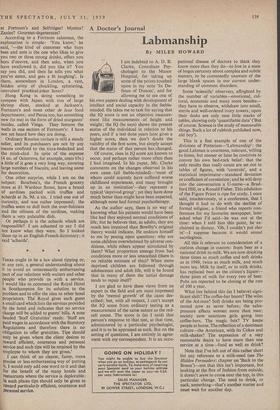A Doctor's Journal
Labmanship
By MILES HOWARD I am indebted to A. D. B. Clarke, Consultant Psy- chologist to the Manor Hospital, for taking up some of the points touched upon in my note 'In De- fence of Dunces', and for allowing me to see one of his own papers dealing with development of intellect and social capacity in the feeble- minded. He takes me to task for saying that the IQ score is not an objective measure- ment like measurements of height and weight; the IQ (he says) shows the present status of the individual in relation to his peers, and if a test done years later gives a higher score, then we don't doubt the validity of the first score, but simply accept that the status of that person has changed.
Of course, rises in IQ score are known to occur, and perhaps rather more often than I had imagined. In his paper, Mr. Clarke comments on the changes observed in his own cases (all feeble-minded)—`most of whom could scarcely have suffered worse childhood experiences, and many brought up in an institution'—they represent a typical 'deprived group' ; yet they have done much better than might have been expected, although none had formal psychotherapy.
As the author says, there is no way of knowing what his patients would have been like had they enjoyed normal conditions of life; but he believes that, as adults, they are much less impaired than Bowlby's original theory would indicate. He endears himself to me by posing open questions: why are some children overwhelmed by adverse con- ditions, while others appear stimulated by them? What proportion emerge from bad conditions more or less unscathed (there is no reliable estimate of this)? When more deprived children are followed through adolescence and adult life, will it be found that in many of them the initial damage tends to repair itself?
I am glad to have these views from an expert in the field and am most impressed by the 'mental growth' of the cases des- cribed; but, with all respect, I can't accept the IQ score from ordinary testing as a measurement of the same nature as the red- cell count. The score is (as I said) that person's response to that test, at that time, administered by a particular psychologist, and it is to be appraised as such. But on the setting of questions, I am entirely in agree- ment with my correspondent. It is an occu- pational disease of doctors to think they know more than they do—to live in a state of bogus certainty about complex and subtle matters, to be contentedly unaware of the large blank spaces in our current under- standing of common disorders.
Some 'scientific' observers, affrighted by the number of variables—emotional, cul- tural, economic and many more besides— they have to observe, withdraw into small, sterile and well-ordered ivory towers; upon their desks are only neat little stacks of tables, showing only 'quantifiable data' ('But of course. Science is the study of measurable things. Such a lot of rubbish published now, old boy').
This is a fine example of one of the divisions of Potterism—'Labmanship': the good Labman is courteous, tolerant, willing to listen, but sooner or later he contrives to convey his own bed-rock belief: that the only results that really count are set out in tables of figures, with 'controls', and a statistical imprimatur—standard deviation or coefficient of correlation; and he will drop into the conversation a U-name—a Brad- ford Hill, or a Ronald Fisher. This adulation of the Figure Priest is ripe for study. I once said, mischievously, at a conference, that I thought it had to do with the decline of formal religion; a friend who reports con- ferences for my favourite newspaper, later asked what I'd said—he was out at the time: when I told him this point, he ex- claimed in dismay, 'Oh, I couldn't put that in'—I suppose because it would sound sacrilegious.
All this is relevant to consideration of a curious change in custom: from beer as a national drink to milk. We are now drinking three times as much coffee and soft drinks as in 1949, twice as much milk, and much more tea. Milk by itself, or in milk drinks, has replaced beer as the citizen's liquor— three pints of milk for every two of beer. Pubs are reported to be closing at the rate of 100 a year.
What lies behind this (as I believe) signi- ficant shift? The coffee-bar boom? The wiles of the Ad-man? Soft drinks are being pro- moted now as never before; the sales- pressure affects women more than men; society now sanctions girls going into coffee-bars. The magic box? TV keeps people at home. The reflection of a dominant culture—the American, with its Cokes and milk-shakes? The expression of a very reasonable desire to have more than one service at a time—food as well as drink? Note that I've left out of this rather short list any reference to a milk-need (see The Hidden Persuaders: chapter on 'Back to the Breast')—not that this isn't important, but looking at the flux of fashion from outside, it doesn't seem to come near the top, in this particular change. The need to drink, or suck, something—that's another matter and must wait for another day.






























 Previous page
Previous page